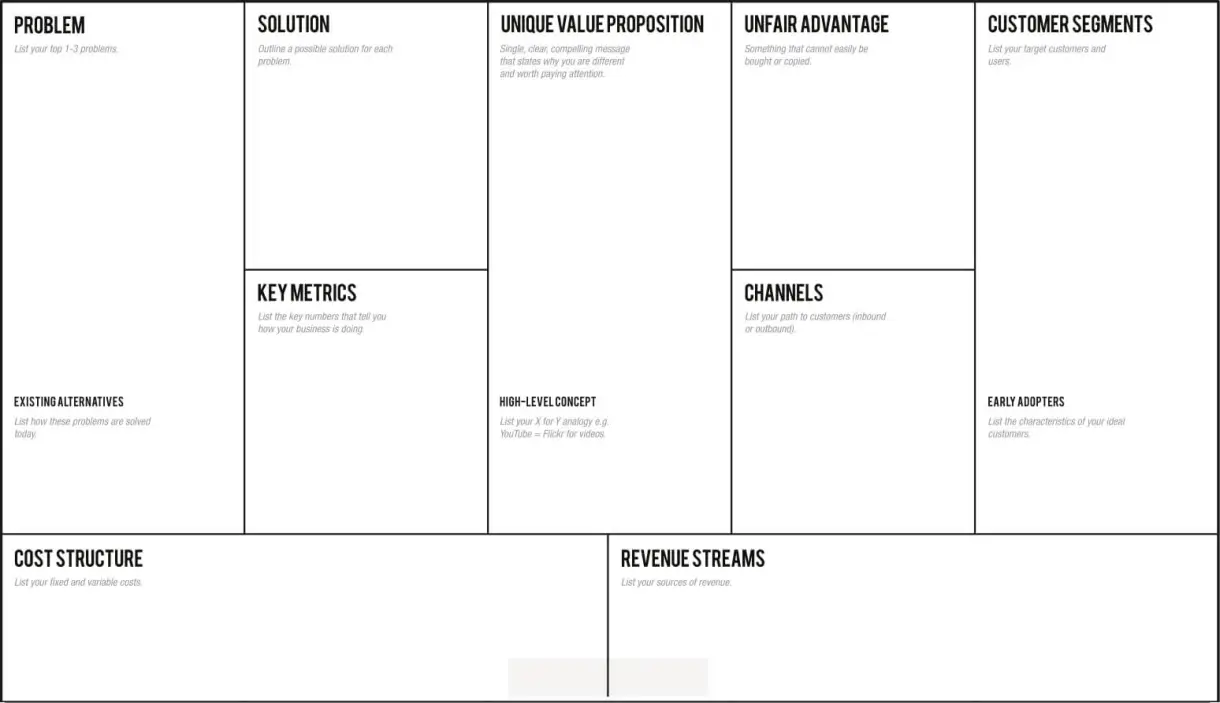Origin
The Lean Canvas was developed by Ash Maurya in 2010 as an adaptation of Alexander Osterwalder’s Business Model Canvas. It is a simplified tool focused on creating startups (Lean Startup), aiming to describe and iterate quickly on the business model of a company. In our case, we use it to help in our product vision construction. Let me provide you with a brief context so that we can delve into a concrete case and fill out the Lean Canvas together!
Context for applicate Lean Canvas
We want to create an administration application for driving schools that is accessible to a computer novice. It will offer features such as managing client records, booking driving slots, and accessing schedules. Our application will stand out for its simplicity of installation and use, offering a modern and responsive design that is accessible on smartphones, tablets, and PCs. The application will also provide innovative content to simplify the learning process for driving to our users and facilitate the booking of driving slots.
Product Vision
To enable driving learning for everyone by offering a modern, interactive, and accessible application. To help new drivers become competent, confident, and responsible by providing an innovative learning method.
Filling out the Lean Canvas
Key Customer Segments
Who are your customers? And your users?
- Students looking to obtain their driver’s license.
- Busy individuals with packed schedules needing flexibility in driving lesson scheduling.
- People seeking interactive learning resources to prepare for the theoretical driving exam.
Problems
What are the main problems or needs of your customers that you want to address?
- Students looking to obtain their driver’s license often lack flexibility in terms of lesson schedules and locations.
- Access to practical and interactive learning resources to prepare for the theoretical driving exam is limited.
- The high costs associated with traditional driving school courses can be a barrier for some students.
Solutions
What solutions does your offer provide?
- Develop a user-friendly mobile application that allows students to plan, book, and track their driving lessons according to their availability.
- Provide interactive and educational learning resources to help students prepare for the theoretical driving exam.
- Offer an affordable online training option as a complement to traditional driving school courses.
Value Proposition
Explain how your product is different and why the customer will be interested in it.
- Flexibility: Allow students to schedule and book driving lessons according to their availability, offering evening and weekend driving options.
- Interactive Learning: Provide interactive learning modules such as quizzes and simulations to make learning the theory of the road code more engaging and effective.
- Affordable Cost: Offer an economical alternative to traditional driving school courses, allowing students to save money while receiving quality training.
Distribution Channels
Through which distribution and communication channels do you reach your customers?
- Mobile application download through app stores (App Store, Google Play).
- Targeted online marketing through social media, search engines, and specialized blogs.
- Partnerships with existing driving schools to promote the application.
Revenue Streams
How does the product generate revenue? Who funds it?
- Monthly subscription fees for application access and learning resources.
- Payment for each booked driving lesson through the application.
- Partnerships with advertisers for targeted advertising within the application.
Cost Structure
What are the launch and maintenance costs of your product?
- Development and maintenance of the mobile application.
- Content creation and regular updates of learning resources.
- Marketing and promotion expenses.
Competitive Advantages
Why is your product different?
- User-friendly and intuitive technology of the application.
- Wide range of interactive learning resources.
- Competitive pricing compared to traditional driving school courses.
Key Metrics
Which metrics do you want to monitor?
- Number of monthly active users.
- Conversion rate from free users to paid users.
What’s Next?
Iterate and Evaluate
Review your Lean Canvas with your team or partners and assess the viability of your product vision. Identify strengths, weaknesses, opportunities, and threats. Use this information to refine your model and make iterations accordingly.
You can conduct experiments and field tests. Identify key assumptions in your model and design tests to validate or invalidate them. This will help you obtain concrete insights into the viability of your project and adjust your model accordingly.
Guide Your Decisions
Use your Lean Canvas to make informed decisions about the direction of your project. The Lean Canvas allows you to visualize the different components of your product and understand how they interact. This facilitates decision-making based on thorough analysis.
Communicate and Unify
Use your Lean Canvas as an internal communication tool to align your team on the vision, goals, and strategies of your product. It can also be used to communicate with partners, potential investors, or other stakeholders to present your business model concisely and clearly.
Continuous Reference
Keep your Lean Canvas handy and refer to it regularly throughout the development of your product. It will serve as a reference to ensure you stay on track and remind you of key aspects of your business model. Are we still aligned with our vision? Are we not deviating too much? Do we need to adjust? Should we change our vision to adapt to the market and new trends?
Miro have a template for Lean Canvas : Lean Canvas Miro Template
